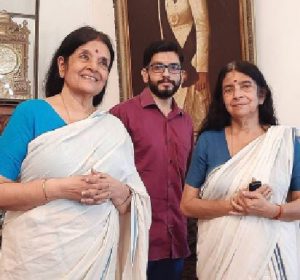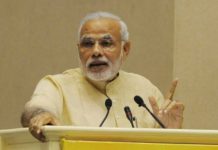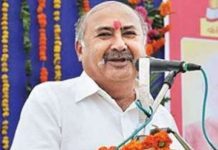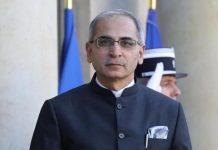 Shree Padmanabhaswamy Temple has been one of the richest in the world and the treasures it holds in its six vaults have always been a cause of controversy. Historians say the temple dates back to the 8th century but the present structure was built in the 18th century by the Travancore Maharaja Marthanda Varma. It is one of 108 Divya Desams or holy abodes of Lord Vishnu, located in Thiruvananthapuram, capital of the state of Kerala. The temple is built in the unique Chera style of architecture, and its main deity is Lord Vishnu in the Anantha Shayana posture (reclined posture of eternal yoga) on Adishesha or king of all serpents. It is known to be one of the 108 holy temples associated with Vaishnavism in India. Committed to Lord Padmanabhaya, the famous Shree Padmanabhaswamy Temple in Thiruvananthapuram is one of the most popular shrines in India.
Shree Padmanabhaswamy Temple has been one of the richest in the world and the treasures it holds in its six vaults have always been a cause of controversy. Historians say the temple dates back to the 8th century but the present structure was built in the 18th century by the Travancore Maharaja Marthanda Varma. It is one of 108 Divya Desams or holy abodes of Lord Vishnu, located in Thiruvananthapuram, capital of the state of Kerala. The temple is built in the unique Chera style of architecture, and its main deity is Lord Vishnu in the Anantha Shayana posture (reclined posture of eternal yoga) on Adishesha or king of all serpents. It is known to be one of the 108 holy temples associated with Vaishnavism in India. Committed to Lord Padmanabhaya, the famous Shree Padmanabhaswamy Temple in Thiruvananthapuram is one of the most popular shrines in India.
The word ‘Thiruvananthapuram’, in common parlance, means – the Land of Sree Anantha Padmanabhaswamy. The temple gave its name to Kerala’s capital Thiruvananthapuram. ‘Thir’ ‘Anantha’ ‘Puram’ means ‘sacred abode of Lord Anantha Padmanabha.’ Padmanabhaswamy is the tutelary deity of the royal family of Travancore. As per holy belief, The Sree Padmanabhaswamy Temple is located at a place that is considered as one of the seven Parasurama Kshetras. There are references to the temple in texts like the Puranas, viz. the Skanda Purana and Padma Purana. The temple stands close to the holy tank — Padma Theertham, which means ‘lotus spring’.
The idol
The main Idol of Shri Anantha Padmanabhaswamy is located in the sanctum sanctorum of the temple. The presiding deity is Lord Vishnu reclining on Anantha (also called as Seshnag or the hooded serpent) with his right hand on Sivalinga , having a lotus in his left hand. The lord Brahma is seen in the lotus flower, which originates from the navel of the Lord Vishnu. The garbhagriha or the sanctum sanctorum of Sree Padmanabhaswamy Temple is located on a stone slab, while the idol is 18ft long and can be seen through three doors. This means head and chest through the first door, hands through the second door and feet through the third door. This posture is called as Anantha Sayanam meaning Yogic sleep. The idols of Sridevi, Bhudevi along with Narasimhaswamy, Ganapathi and Gajalakshmi could be seen beside this idol. The head and chest are seen through the first door; while the hands can be sighted through the second door and the feet through the third door.
The Legacy:
The Travancore royal family was the ruling house of the Kingdom of Travancore. The antiquity of the temple is not known. In 1750, Marthanda Varma dedicated the kingdom of Travancore to Lord Padmanabha. Marthanda Varma vowed that the royal family will rule the State on behalf of the Lord and he and his descendants would serve the kingdom as ‘Padmanabha Dasa’ or the Servant of Lord Padmanabha. This temple had been closely associated with the political history of Travancore. The kings, who succeeded him, ruled the kingdom as vassals of the deity and managed the temple’s affairs and its riches as the deity’s representative and as per their ancestor’s instructions. Since then, the name of every Travancore King was preceded by the title ‘Padmanabha Dasa’. The donation of the kingdom of Travancore to Padmanabhaswamy was known as ‘Thripadidanam’. Thus, Travancore as a whole became the property of Sri Padmanabhaswamy, the deity of the Travancore royal family. Thereafter, the title of ‘Sree Padmanabhadasa’ would be prefixed to the name of every Travancore King, while the royal women would be ‘Sree Padmanabhasevinis’.
But to attain the title of ‘Sree Padmanabhadasa’, certain ritual has to be completed at the birth of new royal male members. On the first birthday of every royal male member, he is put on the ‘Ottakkalmandapam’ of the Sree Padmanabhaswami Temple. Thereafter, holy water from the temple is sprinkled on the baby. Only after completion of this ceremony, the royal child is proclaimed as ‘Sree Padmanabhadasa’. The female members also have a ritual called ‘Padiyettam which is conducted only after their ‘Pallikettu’ (i.e. wedding of Travancore Princesses and Queens). Only those male and female members who complete these ceremonies are allowed in the temple affairs, provided respect as well as the titles associated with temple as well as the royal family.
The Travancore Royal Family follows the matrilineal inheritance i.e. ‘Marumakkathayam’. Inheritance and succession through the sisters’ children in the female line.
 The sprawling temple, an architectural splendour in granite, was rebuilt in its present form in the 18th century by the Travancore Royal House which had ruled southern Kerala and some adjoining parts of Tamil Nadu before integration of the princely state with the Indian Union in 1947. On 1st July, 1949, the State of Travancore-Cochin was established, with the Maharajah of Travancore as the Rajapramukh of the new State. Under the State Reorganisation Act of 1956, the four southern taluks of Travancore, namely Thovalai, Agasteeswaram, Kalkulam and Vilavancode and a part of the Chencotta Taluk was merged with Madras state. The State of Kerala came into existence on November 1, 1956 with a Governor, appointed by the President of India, as the head of the State instead of the Maharajah.
The sprawling temple, an architectural splendour in granite, was rebuilt in its present form in the 18th century by the Travancore Royal House which had ruled southern Kerala and some adjoining parts of Tamil Nadu before integration of the princely state with the Indian Union in 1947. On 1st July, 1949, the State of Travancore-Cochin was established, with the Maharajah of Travancore as the Rajapramukh of the new State. Under the State Reorganisation Act of 1956, the four southern taluks of Travancore, namely Thovalai, Agasteeswaram, Kalkulam and Vilavancode and a part of the Chencotta Taluk was merged with Madras state. The State of Kerala came into existence on November 1, 1956 with a Governor, appointed by the President of India, as the head of the State instead of the Maharajah.
The Maharajah was stripped of all his ranks and privileges according to the twenty-sixth amendment of the Indian constitution act of 31st July, 1971.The Travancore royal dynasty lost their ruling rights in 1949 when Travancore merged with India and their remaining privileges were abolished in 1971. But, even after India’s independence, the temple continued to be governed by a trust controlled by the erstwhile royal family until 1991, when the last ruler of Travancore, Chithira Thirunal Balarama Varma, passed away. After the death of the last Travancore ruler in 1991, the state government allowed the management of the temple to be taken over and retained by his younger brother, Uthradam Thirunal Marthanda Varma.
As history says, there were indeed hundreds of temples under the control of the rulers of Travancore and Cochin just before the two princely states merged as a Travancore-Cochin State. These temples were subsequently brought under the control of the State-run devaswom boards. But, the Sree Padmanabhaswamy temple alone remained ‘vested in trust’ in the ruler of Travancore, a condition the last Maharajah Chitra Thirunal insisted during the integration of the princely state with the Indian Union as part of the Agreement of Accession that he signed with the Government of India.
This condition in the accession agreement was later incorporated in the State law governing the administration of temples (the Travancore-Cochin Hindu Religious Institutions Act, or the TC Act, 1950) after the reorganisation of the States.
Until the death of Chitra Thirunal (on July 20, 1991) and for several years thereafter when his brother, Uthradam Thirunal Marthanda Varma, the next eldest member of his family, retained the management of the temple, there had been no challenge to the legal position that the temple “vested in trust in the ruler of Travancore”, who controlled and managed it through an executive officer. When Utradam Thirunal Marthanda Varma claimed that the treasures of the temple are the properties of the royal family, many devotees objected to and challenged his authority to run the temple in many lower courts.
The legal battle:
The Division Bench of the Kerala High Court in its order dated 31st January 2011 (on the basis of a writ petition filed by Marthanda Varma challenging lower court orders that went against him), observed that “public resentment had started when the last ruler’s brother…, who took over the control and management of the temple, arranged to take photographs of the treasures of the temple and made a claim in the Malayalam daily ‘Kerala Kaumudi’ on 15th September,2007 stating that the treasures of the Padmanabha Swamy Temple are the family properties of the erstwhile royal family of Travancore”.
When a lower court passed an injunction against the opening of the treasure vaults of the temple, Marthanda Varma approached the High Court.Sri T.P. Sundara Rajan, a former Indian Police Service officer and a devotee, also had filed a petition in the High Court seeking the issue of a writ of quo warranto against the (then) executive officer of the temple who he claimed the last ruler’s brother had appointed without any authority whatsoever. Sundara Rajan was described in the verdict as “the licensee of premises belonging to the temple, against whom the management had taken steps for eviction”.
The Kerala High Court observed that the only issue to be considered was “whether the description ‘Ruler of Travancore’ would include the brother of the last ruler (Chitra Thirunal) who had died on 20.7.1991”. The High Court ruled that the status of the ruler was not heritable, that ‘ruler’ is not a status that could be acquired through succession, and that Uthradam Thirunal Marthanda Varma or his successors of the royal family will not come within the description of ‘ruler’ as defined under Article 366(22) of the Constitution. Pointing out that the TC Act provided for “vesting of the temple in trust” in the hands of the last ruler of Travancore, the High Court said that since there was no provision in the TC Act to vest the temple “in the next senior member of the royal family after the death of the ruler of Travancore”, the temple and its properties and assets would revert to and vest in the State government.
What is shebaitship?
In upholding the ‘shebaitship’ of the former royal family of Travancore, the Supreme Court has, essentially, conferred upon the royal family, the rights to administer the property, effectively, in the position of a trustee. The Supreme Court set aside the High Court judgment.
‘Shebaitship’ predominantly involves two concepts — the ministrant of the deity and its manager, and relates to an office that claims certain rights. A shebait has no legal claim to the property, which is believed only to rest in the deity (or idol). A shebait is a manager of the property only in title, and as such, is entitled to custody of both, the property and the idol.
A shebait is responsible for the management and preservation of the property, and is allowed to incur any debts towards this undertaking. A shebait also reserves the right to defend the property against any hostile litigation, and protect the property from being bought. However, a shebait cannot, in any circumstance, purchase any part of the property. Moreover, the office of shebait is hereditary unless stipulated otherwise, or stated by the creator of the religious endowment.
The game change
The apex court said, “According to the settled principles, the ‘Shebaitship’ is like any other heritable property which would devolve in accordance with custom or usage, and that the rule of custom must prevail in all cases, even after the death of the erstwhile Ruler of Travancore in 1991 — the Shebaitship of the Temple being unconnected with the official status of the person who signed the Covenant, must devolve by the applicable laws of succession and custom.” The apex court observed: “Going by the normal incidents of Shebaitship including the heritability, the context in which the expression was used in Article VIII of the Covenant, and carried in the provisions of the TC Act, it must be held that such expression must include the successors to the person who had signed the Covenant.”
Despite the Constitution (26th Amendment) Act, 1971, which had put an end to privy purses, even though concepts such as Ruler or Rulers hip had ceased to operate, “the private properties of the Ruler would continue to be available for normal succession and devolution in accordance with the law and custom”. The Constitution (26th Amendment) Act, 1971, did not in any way impact or affect the administration of the Temple, Sri Pandaravaga properties and the properties of the Temple, which continued to be under the control and supervision of the Ruler of Travancore,”
The landmark judgment not only upholds devotees’ rights but is also a ‘game changer’ in terms of giving importance to faith and religion, rituals and heritage.
The author is an Associate Professor & Dean at National University of Study & Research in Law, Ranchi. Views expressed are her own
letters@tehelka.com













